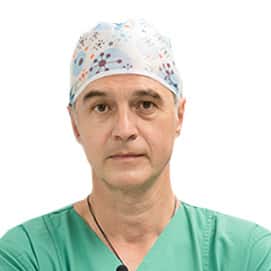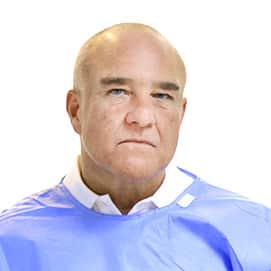In the Clinic of Coloproctology, equipped with the latest diagnostic and surgical equipment, the patient will be met by highly qualified medical staff, headed by the head of the clinic, Dr. med. sci. David Tuschek. Here the patient expects not only competent examination and treatment, but also sensitivity, compassion and psychological support, which is necessary for recovery. There are no “embarrassing” questions for the Clinic staff. The more freely the patient speaks about his illness, the better and faster his treatment goes.
The clinic is specialized in the treatment of diseases of the large intestine, including diseases of the anal canal. Thanks to the latest equipment of the highest class, knowledge and skills of employees, unique operations are performed here, which until recently were carried out only in rare cases in some clinics in Germany. The spectrum of these operations includes the treatment of stool incontinence, severe constipation, in particular in cases of elimination problems.
Haemorrhoids
Hemorrhoidal vessels form natural plexuses in the final section of the large intestine and provide, together with the anal muscles, the work of the closing sphincter. This ensures tight closure of the anal sphincter even during sleep. During bowel movements, with straining (defecation) and the passage of solid feces, these anatomical structures shift down and increase.
The severity of the changes is presented below, as the stage of the disease with hemorrhoids.
- 1 stage. Internal, unexpressed, painless nodes, sometimes traces of blood on toilet paper, sensation of a foreign body, burning.
- 2 stage. Palpable nodes appear when straining and emptying the intestines, sometimes redness of the skin around the anus.
- 3 stage. Obvious prolapse of hemorrhoids, partially reducible, mucous discharge from the anus.
- 4 stage. Unreduced external hemorrhoids, severe pain, bleeding when pinched.
Treatment methods for hemorrhoids
Treatment depends on the severity of the process. If in the first stages local application of ointments is sufficient and effective, then the following methods of treatment are widely used in severe stages of the disease.
- The imposition of rubber ligatures - Barron ligatures
With the help of a special apparatus on an outpatient basis, rubber ligatures (rings) are applied to enlarged (Article 2) hemorrhoids. Thus, the blood flow to the hemorrhoids is blocked and after a few days they painlessly subside. With clearly enlarged nodes, this manipulation is repeated.
- Ferguson method
With this method, hemorrhoids located at 3, 6 and 9 o'clock are removed using a high-frequency electric scalpel. Small wounds are sutured with a special self-absorbable suture material. The operation is performed under conditions of a short stay in the hospital.
- Longo method
During this operation, with the help of a special apparatus, the rectal mucosa with hemorrhoids is simultaneously captured, sutured and removed. The device is placed above the closing muscle ring, in a zone free from nerve endings, so the intervention is almost painless.
anal fissures
Small cracks in the anus often occur with constipation tendencies, hard hard stools and overexertion of the pelvic floor muscles. This leads to severe pain during bowel movements. In the initial stages, treatment is carried out with the help of ointments, with long-term non-healing cracks, one has to resort to sparing excision of cracks within the mucosa with maximum preservation of the underlying muscle layer (Fisurectomy). In extremely rare cases, it is necessary to resort to a partial dissection of the muscles of the closing sphincter (sphincterotomy).
Anal fistulas and abscesses
They talk about anal fistulas when, during the course of the disease, an anastomosis is formed between the large intestine and the skin surface. As the fistula passes through the trailing or pelvic floor muscles, it may become suppurated (anal abscess). Chronic fistula formation and prolonged inflammation lead to a significant deterioration in the function of the trailing ring, which ultimately requires surgical intervention. Festering fistula, anal abscess - these are extremely serious diseases accompanied by high temperature (fever), redness of the skin, deterioration of the general condition, in extremely rare cases leading to the entry of bacteria into the general bloodstream - anal sepsis. First, it is necessary to open the abscess and, if possible, determine the course of the fistula . After 4-6 weeks, when the acute phase of inflammation has passed, a proctological examination and a complete diagnosis of the fistula are performed. perianal thrombosis. Mariskins With strong straining, blood clots can form in the external skin vessels. They look like bluish, painful nodules (perianal thrombosis). In the first days, blood clots resolve with local treatment or anesthesia with the use of ointments, in the future, the nodules can be removed on an outpatient basis with minimal intervention. With mariskins, we are talking about a harmless itching of the anal fold, which is a consequence of a resolved (resolved) anal thrombosis. In addition to the feeling of a foreign body, Mariskins no longer manifest themselves in any way, but they can become complicated and make it difficult to hygienic care. Surgical removal can be performed on an outpatient basis under local anesthesia.
Encoprese
When the self-controlled retention of air and feces is lost, we have to speak of incontinence. Although the causes and manifestations of incontinence are very diverse, all this leads to a significant deterioration and limitation of living conditions. This is a special issue in proctology and, in addition to accurate diagnosis (anal manometry, deficography, etc.), it requires a purely individual approach: physiotherapy, training of the pelvic floor muscles up to a specific surgical aid (levator plastic, sphincter formation), which is naturally discussed and agreed with sick.
More than 1,500 inpatients and more than 2,000 outpatients are treated at the clinic every year.
Head of the Clinic for General, Visceral and Minimally Invasive Surgery
Head of the Clinic for General, Visceral, Thoracic and Endocrine Surgery
Video
Request appointment
Useful links
Photo gallery










